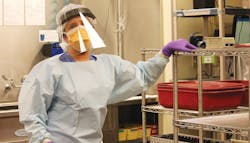Technician the centerpiece of effective sterile processing
Instrument processing quality is directly related to the knowledge and application of the knowledge by the technician preforming the work. Thus, the most important link in the processing chain is the technician doing the work – be it cleaning, inspecting, packaging or sterilization. If the technician does not follow the manufacturer’s instructions-for-use (IFU) for each step then risk to the instrument and/or patient increases.
Flexible endoscopes are used in many different specialties. Within a hospital, processing flexible endoscopes that are used in the Operating Room (OR) are typically done in Sterile Processing and Distribution (SPD). If the hospital has a separate gastrointestinal (GI) endoscopy clinic or suite, these flexible endoscopes are typically processed in that department. The GI endoscopy department generally maintains a smaller processing staff than is found in the SPD. Due to this, training is not as big of a challenge because the technicians are focused primarily on flexible endoscopes and their accessories. Comparing this to the SPD, where in most departments everyone is trained to process every instrument in the hospital and is expected to know them and their IFUs, the task of training is much harder. In fact, it’s close to impossible given the number of staff members, skills and high turnover that most SPDs experience.
For SPDs the root cause of most quality problems is a fundamental flaw in SPD structure and the relative importance of SPD functions not being prioritized appropriately by hospital leadership. These flaws we find at most SPDs across the country. Centralized SPDs were created to bring standardization to the cleaning, inspection and sterilization of all surgical instruments within a hospital and to remove instrument processing from the OR area. When centralization occurred, most of the instruments cleaned and processed were general in nature (non-complex). Over the last 30 years, there has been a rapid expansion in surgical procedures that required complex instruments (e.g., endoscopes, endoscopic instruments, power tools, robotics, etc.) and implants. These complex instruments and implants require a much higher level of knowledge and competency to effectively clean and process versus general instruments.
Flexible endoscopes fall into the category of Complex Instruments versus General or Non-Complex Instruments. General or Non-Complex Instruments are represented by stainless steel hand instruments (e.g., scissors, forceps, curettes, etc.). Complex instruments cost in the thousands of dollars to purchase and for repair.
With advancements in surgery, OR staff specialize and focus on specific procedure types. Unfortunately, SPD was not afforded this same opportunity, creating a significant delta in knowledge of the instruments. In essence, the OR moved forward with a mass manufacturing model where specialization is the norm, while SPD operates at a cottage industry level where every technician is expected to be expert with every instrument and how to process it according to the manufacturers’ IFUs. Due to this gap, variation in quality is the norm as instrument/set quality is dependent on the technician who prepared it. Good technicians produce high-quality while less educated or motivated technicians produce lower quality work, creating an average that is well below 100 percent high quality for the department. This variation is felt by surgeons, nurses and patients. Training everyone and allowing everyone to clean and process flexible endoscopes is a major mistake. This system of rotating technicians through SPD or GI departments leads to a significantly greater chance that IFUs will not be followed, higher repair costs will occur and greater variability in the cleanliness and safety of the endoscope.
How to specialize SPD
While it is not feasible to allow for specialization in SPD at the same level as specialization occurs in the OR or GI clinic due to scheduling/expense issues, it is possible to separate SPD functions into manageable and meaningful subsections so that specialization occurs. In addition, it is possible to expand responsibilities for the specialists to include roles in the OR related to room setup and instrument transport. This direct connection to the OR will increase communications and cooperation. By default, separating responsibilities for complex instruments from general instruments greatly decreases responsibilities for the general instrument staff allowing them to focus on the less complex instruments/ procedures. The result is improved performance by all SPD staff.
Generalists will always be at a significant disadvantage compared to specialists with regard to processing complex instruments. Every GI endoscopy center and SPD should look at their current organizational structure and evaluate if their quality could be improved through additional training, competency assessment and management support. Contacting companies that can assess current operations without bias can be very helpful in this analysis.
The second item that must be recognized is that often the trainers who teach how to process complex instruments often are not experts with the equipment. This creates a situation where processing faults are perpetuated. In the past week we witnessed a certified flexible endoscope technician, who trains others, first submerge the flexible endoscope in water before connecting the air pump. This step would cause the endoscope to flood if it had a hole. This facility had a high number of major category repairs ($10,000+), and we suspect that this practice contributed greatly to this extra expense. Unfortunately, this lack of knowledge by a trainer is not an isolated incident as we have witnessed similar faults across the country.
Technicians must not only know the steps, but understand why they are doing them. This requires knowledge beyond just following the IFU. Understanding the function of the instrument, its internal components, accessory instruments and how they all work together all assist the technician in inspecting and testing the device. This level of knowledge comes with time, motivation and proper training and is greatly enhanced if the technician is allowed to specialize.
The third item that must be recognized is that there are several different types of flexible endoscopes, and each manufacturer’s model comes with different and distinct IFUs. There are large and small diameter endoscopes which can be further subdivided into video and fiberoptic (see chart above). Examples of large diameter flexible endoscope are gastroscopes, colonoscopes and bronchoscopes. Small diameter flexible endoscopes are intubation, rhinolaryngoscopes cystoscopes and ureteroscopes. In addition, these two groups can be subdivided into digital and fiberoptic. Digital endoscopes gather and transmit images via CMOS or CCD (chips). Fiberoptic flexible endoscopes transmit images via flexible glass fibers.
GI Endoscopy departments have an advantage in that their staff typically is smaller and totally focused on reprocessing flexible endoscopes and their accessories. In SPD, there are more staff members, each expected to be an expert with every instrument’s IFU for cleaning, inspecting, packaging and sterilization. Specialization is a key to achieving goals of 100 percent instrument availability, functionality and safety.
About the Author

Gregg Agoston
Vice President, Minimally Invasive Surgical Support
Gregg Agoston is Vice President, Minimally Invasive Surgical Support at SpecialtyCare, which provides allied high and outsourced operating room services.

